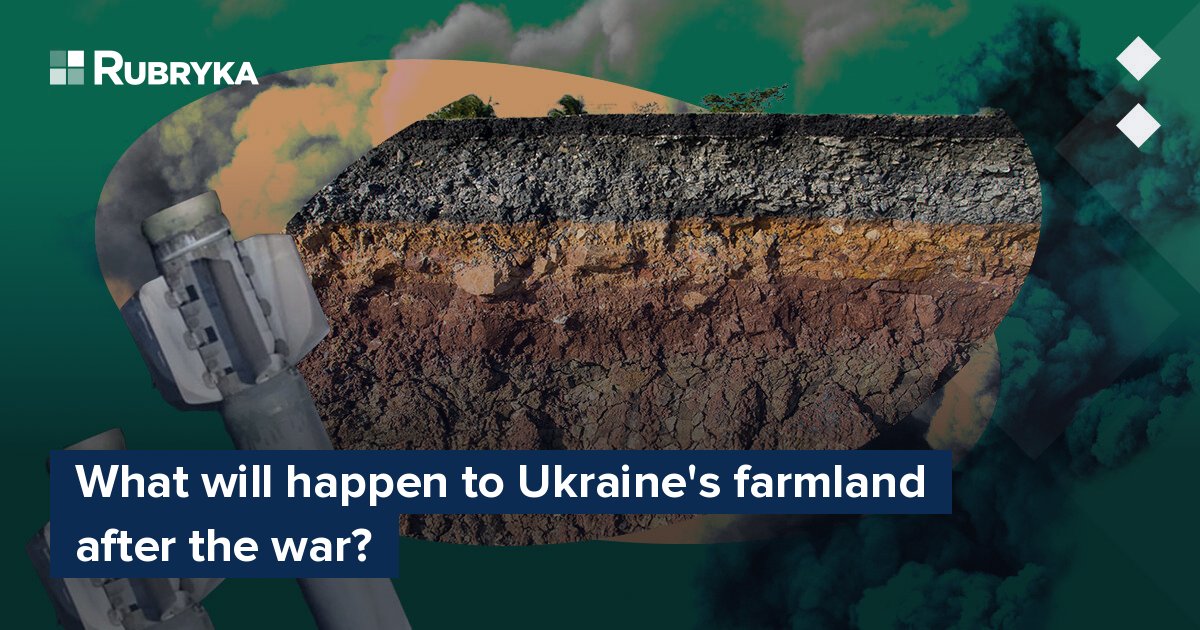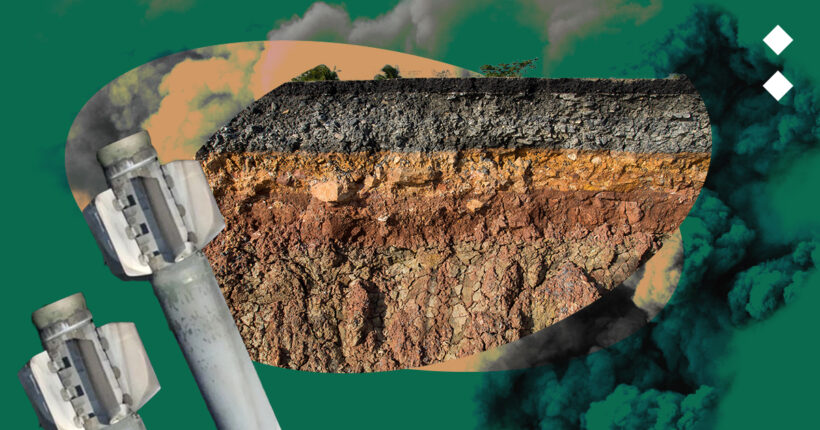
What's the problem?
Russia's full-scale war against Ukraine has been ongoing for over two years. The front line keeps shifting, and entire cities are being destroyed in the "red zone," not to mention the burned forests and other areas that have become battlegrounds. Craters from artillery strikes are visible even from space — the photo below shows agricultural fields near the village of Toshkivka in the eastern Luhansk region. The available image is from 2022 — the early stage of the invasion — so it's hard to imagine what these farming areas look like now.
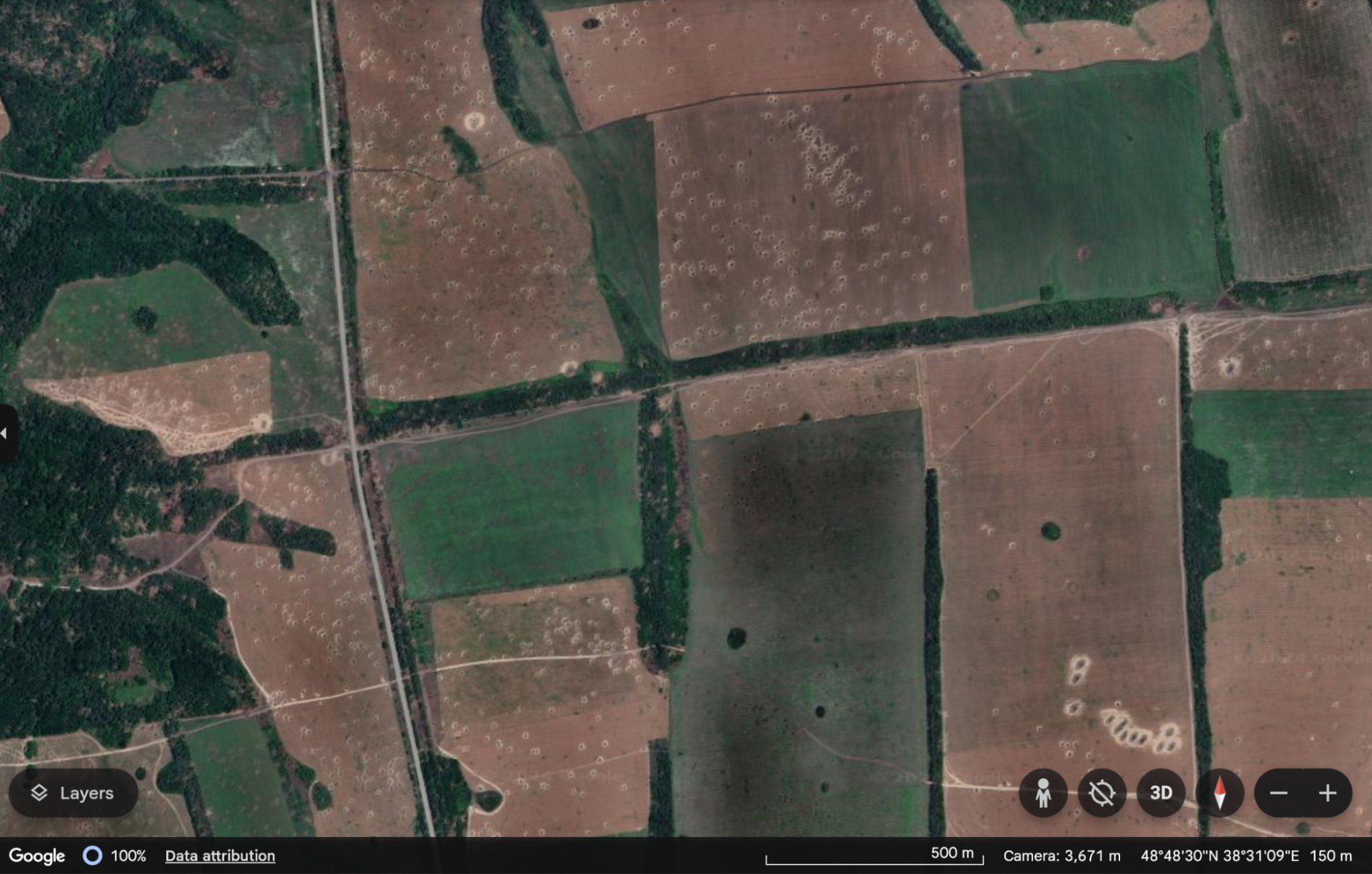
Agricultural fields near Toshkivka, Luhansk region, 2022
These war-altered terrains are known as belligerent landscapes. They are shaped by explosion craters of various sizes, trenches, and fortifications, often built in fields, and the movement of heavy machinery. According to experts from the Ukrainian public organization Ecoaction, all these changes to the soil surface lead to changes in its structure.
The Ecoaction's soil study explains how this kind of "mechanical contamination" can harm the soil. The fertile layer, which has developed on the surface over many years, gets destroyed and mixed with other layers. As a result, it loses its properties, retains moisture less effectively, and becomes less suitable for growing crops.
There are also physical and chemical contamination types. Physical damage alters the soil's physical properties. It can occur during fires, changes in temperature, and soil compaction, all of which affect biodiversity. Microorganisms and insects, which play a vital role in creating new soil, simply die.
Chemical contamination involves soil pollution caused by fuel leaks and combustion products that settle in the air. It can pose a health problem not just for the land but also for people. Hazardous substances can seep through the soil into water or crops, entering the human body through drinking or eating contaminated food.
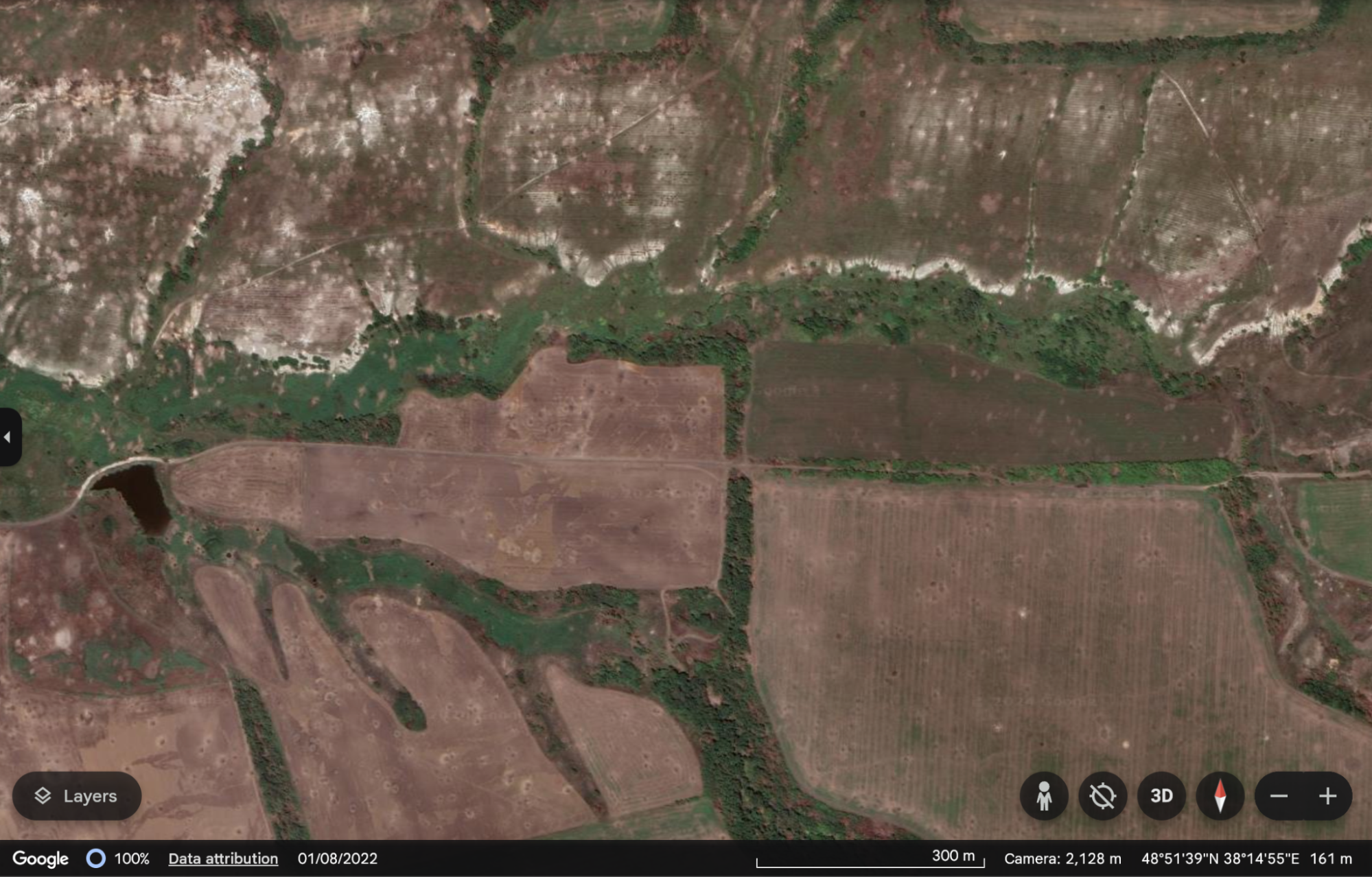
Fields near the village of Verkhokamianka, Luhansk region, 2022
Pollution, however, isn't the only issue. All fields along the front line are considered potentially mined and pose a threat of unexploded ordnance. If the demining takes too long and occupied territories are not returned to Ukrainian control, agriculture — Ukraine's most profitable sector — will face serious consequences. According to a Top Lead study, Ukraine's economy could lose $800 million annually due to unusable mined fields. These articles by Rubryka provide more context on demining in Ukraine.
All these factors create a somewhat degraded and unusable landscape after the war ends. However, available technologies for soil restoration and new demining efforts in Ukraine can help the recovery. This article will explore the solutions being developed and which ones Ukrainian farmers can use.
What's the solution?
The top priority for making agricultural fields safe again is demining. In early 2024, about 156 million hectares of land across Ukraine, including occupied territories and water areas, were considered potentially mined. While it's unclear how much of this land is agricultural, reports show that Ukrainian sappers demined and returned over 156,000 hectares of farmland to use during the first six months of this year alone. The best progress was recorded in the southern Kherson region, with 146,000 hectares cleared — almost 60% of the area planned for demining this year. Sappers also demined 11,300 hectares in the northeastern Kharkiv region and 8,300 hectares in the southern Mykolaiv region.
The demining is ongoing in Ukraine, with agricultural fields being a secondary priority after residential areas and infrastructure. Farmers can also request humanitarian demining services. Ukraine also receives support from international partners who provide specialized equipment.
After demining, various types of pollution — mechanical, physical, and chemical — will make fields unusable and must be dealt with. Fortunately, available technologies can address these issues, which we will discuss further.
"Nature islands" instead of shell craters
Many innovative projects and methods based on other countries' experiences are being used to restore damaged agricultural lands. For instance, environmental activists from WWF-Ukraine propose effective "nature-based solutions" like creating "green islands" in fields where farming activities are limited due to specific soil damage.
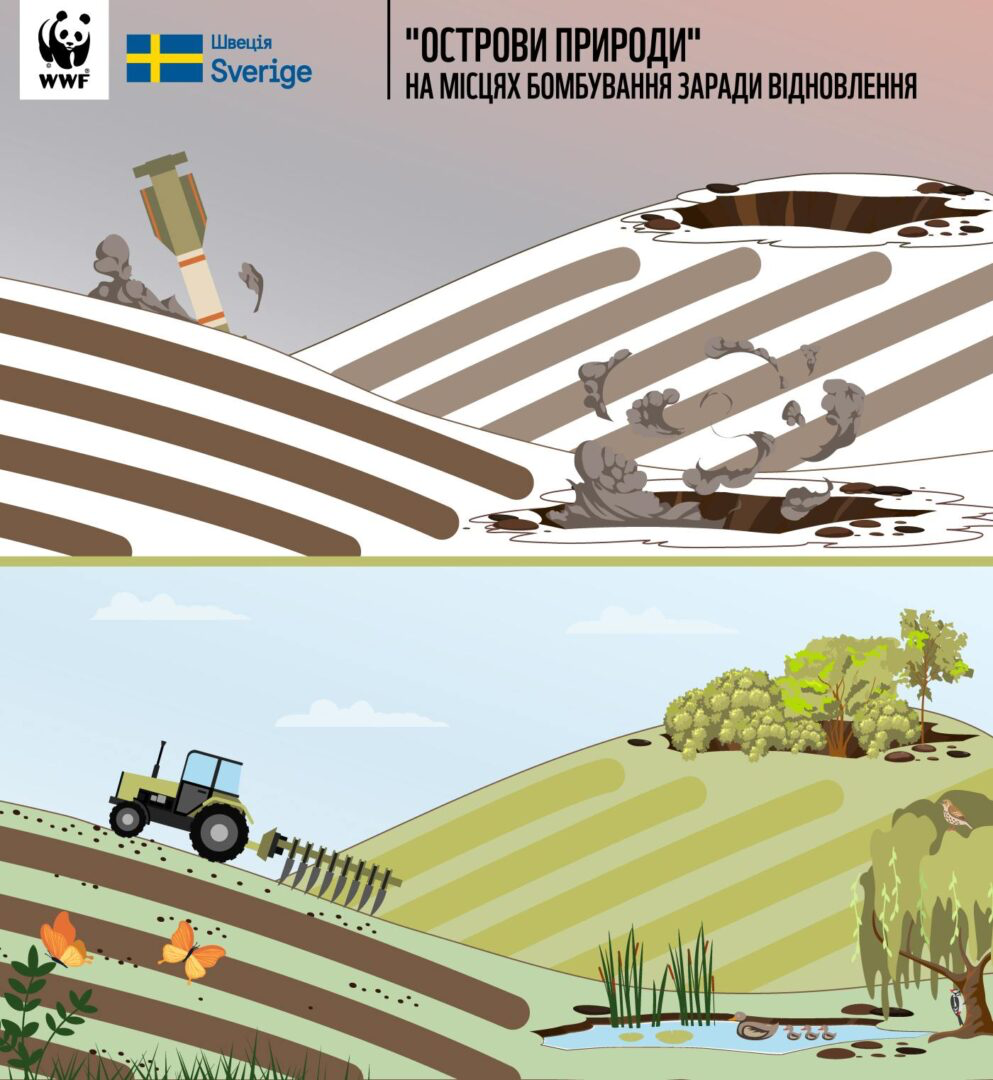
"Nature islands": This is WWF-Ukraine's proposed solution for fields affected by shelling. Green islands with plantings and small bodies of water can stabilize the ecosystem and prevent soil erosion in areas with craters and war-damaged landscapes. Source: linked here
Turning explosion craters into small artificial forests, thickets, and ponds, especially when combined with protective windbreaks, can provide farmers with free ecosystem services — benefits that humans derive from healthy ecosystems — within just a few years:
- Windbreaks can reduce wind speed by at least 25%, which helps prevent soil erosion.
- Microclimate conditions in the field stabilize: air humidity increases by 5-20%, soil moisture rises by 15-30%, and evaporation decreases by 20-25%.
- The number of pests in the field decreases for several reasons: hundreds of insect-eating birds, which serve as a natural "biological weapon" against pests, settle in the craters. The number of invertebrate species, including wild bees and other pollinators, predatory ground beetles, spiders, and ants, also increases—all of these help control field pests.
- Humus content increases by 20-40% and soil porosity by up to 9%, which boosts fertility.
- Tree plantings absorb and bind chemical elements in different soil layers, helping to clean groundwater and reduce chemical pollution.
- Crop yields increase by 20-30% — a benefit similar to that provided by protective windbreaks — due to several factors: the nutrient cycle becomes more intense, "nature islands" reduce windiness, and thus protect the soil from erosion.
New solution to chemical pollution of soil
Topsoil removal is a common practice for soil cleaning and battling chemical contamination. It involves "mechanically scraping away the topsoil with bulldozers and graders without considering the soil's internal structure or genetic horizons." In other words, the procedure removes the richest layer of soil and damages the soil's fertility. Because it takes many years for fertility to recover, it significantly affects the quality and quantity of crops but potentially makes them safer, with lower levels of heavy metals and other chemicals left behind by exploding munitions.
The Sokolovsky Institute of Soil Science and Agrochemistry of Ukraine's National Academy of Agrarian Sciences has proposed an alternative method for helping the soil recover more quickly after harsh reclamation. Their solution involves planting giant miscanthus silvergrass, a drought-resistant energy crop that doesn't require annual plowing for 25-28 years and grows without fertilizers.
In addition to its revegetation function, its cultivation could help Ukraine develop green energy and achieve energy independence. The plant can provide relatively cheap biomass energy, producing 17-25 tons per hectare of dry matter by the third year of growth.
Scientists also highlight other benefits of using miscanthus biomass, including no negative impact on the carbon dioxide balance in the atmosphere and significantly lower sulfur oxide emissions (20-30 times less) and ash content (3-4 times less) compared to coal.
According to scientists, the plant's extensive root system sequesters a substantial amount of carbon, gradually converting it to humus. While the plant improves soil properties and biodiversity and ultimately helps restore soil fertility, the cultivation has downsides because it requires significant financial and time investment.
Ecological succession or conservation
Some areas have the potential for natural recovery. One powerful natural restoration method is ecological succession — the gradual, irreversible, and predictable replacement of one biocoenosis or biological community by another in a particular area. This process takes a long time, and the succession results will only become noticeable after several decades. However, this optimal method allows the ecosystem to form naturally.
Examples of successional recovery can be seen on World War I battlefields. For instance, at the Newfoundland Memorial Park in Beaumont-Hamel, France, you can see deep and long defensive trenches and numerous smaller craters left by shell explosions from a bird's-eye view. The greenery in the area has fully recovered over the past century.
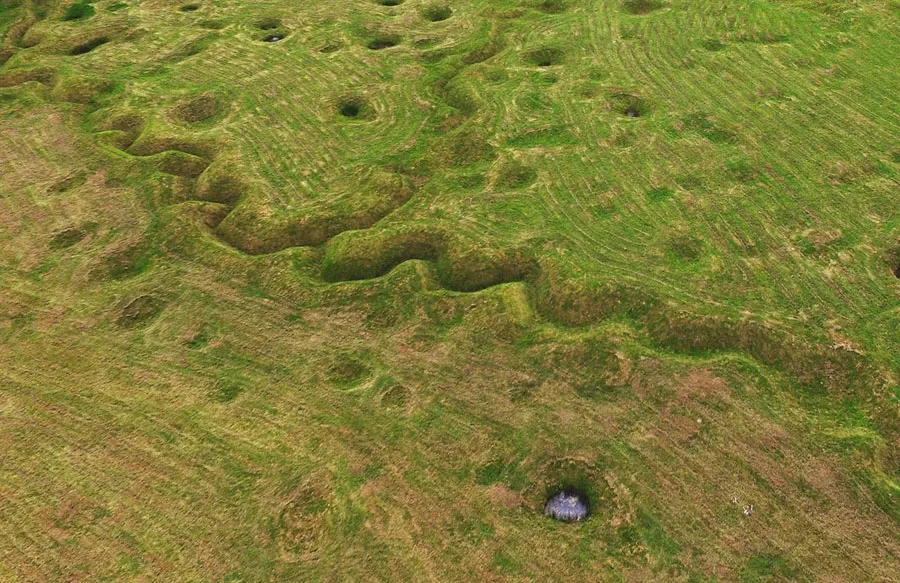
Beaumont-Hamel, France: The landscape here was shaped by trenches and craters from explosions.
In some cases, however, the landscape could not fully regenerate through succession. The soils on the fields in Verdun, France, have not recovered their properties, and these areas are now considered unsuitable for living and human activity. This entire area is known as the Red Zone. Agricultural activities are prohibited, and the land is considered a natural reserve. Some parts of this area remain inaccessible to visitors even 100 years after the war ended.
Other soil cleaning methods include thermal desorption, chemical extraction, stabilization, and more. However, all these methods are costly, and farmers cannot afford them alone. For example, the cost of stabilizing one cubic meter of soil is $50, while chemical extraction ranges from $150 to $500 for the same volume.
Another option for past areas of active combat is conservation. While this solution may not directly benefit farmers, it will help Ukraine achieve its goal of designating 15% of its land for conservation by 2027, as outlined in the State Strategy for Regional Development.
Ukraine faces a lengthy and costly process of cleaning and restoring its soil. First, the country must complete demining and then assess the extent of soil damage, and only after that can it consider reclamation and other cleaning methods. In reality, though, things often work differently. Demined fields are usually put back into agricultural use right away, and quality control and monitoring for harmful substances take place only at the final stage when products are brought to market.
Ukrainian scientists agree on one thing — Ukraine needs to establish laws for land reclamation. At the current stage, legislation is the most pressing issue in the discussion about the safety of Ukrainian soils.
Newsletter
Digest of the most interesting news: just about the main thing



